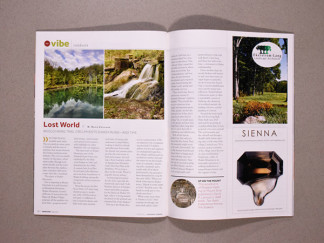In my nearly 20 years as a freelance journalist, I’ve been fortunate to write about many of the people and places I find meaningful. Shaker Mountain, with its blend of history; striking beauty; and living, breathing personality, is one of these memorable places. This article was originally written for Berkshire Magazine.
Lost World
An old hiking trails circumvents Shaker ruins—and time
By Robin Catalano
In this place, footfalls seem softer. The air somehow seems easier to breathe and the rays of sunshine that stream between the birches and pines more brilliant. The soil even smells sweeter. In this place, where water rushes through rock-strewn brooks and the wind plays the trees like tambourines, centuries-old history comes alive like a heartbeat
This place is Shaker Mountain.
Not as imposing as Mount Greylock or as well traveled as Monument Mountain, Shaker Mountain, located off Route 20 across from the Hancock Shaker Village, possesses all the qualities of a great hike—gorgeous woodland setting, varied terrain, and natural water sources—with highlights no other Berkshire trek can duplicate.
The main trail on Shaker Mountain, part of the Pittsfield State Forest, was established by the Hancock Shakers in 1842 and abandoned by the 1860s. Almost a century later, local Boy Scout leader John Manners uncovered the foundations of Shaker buildings among the overgrowth and reconstructed the trail.
From the get-go, the Boy Scout Trail—6.5 miles long, classed as easy to moderate, with a 790-foot elevation gain—is different. It runs counterclockwise, and lacks wide-open summits and views. It’s practically unknown to casual hikers, making it ideal for solitude and reflection. Even under the densest late-summer plant growth, the trail is still easy to find and navigate. And according to René Laubach, author of Appalachian Mountain Club’s Best Day Hikes in the Berkshires, “It’s not just a place in the woods. There’s a palpable history feeling.”
This is because of the archaeological remains that dot the trail, especially the initial mile and a half, which Todd Burdick, director of interpretation and public programs for the Hancock Shaker Village, calls “a living natural document to the spiritual and industrial life of the Shakers.”
First up is the Shaker Reservoir, constructed in 1790, an impressive bit of engineering that held 3.5 million gallons of water and supplied, via underground aqueduct, the village’s sophisticated water-delivery system. Just past the reservoir are the foundations of a sawmill, a thrashing mill, a gristmill, and a textile mill, all of which had burned to the ground or been dismantled for scrap by the early 1900s. “When you think of the famous Shaker motto, ‘Hands to work, hearts to God,’” Burdick notes, “the hands-to-work part is very clearly seen here.”
What comes next, then, is “hearts to God.” After crossing a footbridge, the trail winds uphill, culminating at 1,845 feet in a clearing marked by a low, white wooden fence. This is Mount Sinai, named for the biblical location where Moses received the Ten Commandments, and was where the line between the celestial and corporeal realms blurred during the Shakers’ yearly spring and fall worship services.
“They called it their feast grounds,” explains Burdick, “not for food, but a feast of spiritual goodness. They would sing, dance, and receive visions of heavenly blessing. They would also receive visitations from angels and departed spirits. Today, people can feel the spiritual even if they don’t quite know what they’re feeling.” So, it would seem, do the grouse and deer that linger here, often long after they’ve eaten their fill of strawberries and elderberries.
With all the history packed into the early portion of the Boy Scout Trail, the remainder might seem to be, well, all downhill. Yet on the descent from Mount Sinai, there’s a fragmented stone wall that once bordered open pastures. Near the top of a second worship site (Holy Mount, used by the New Lebanon Shakers) is an exceptionally well-preserved piece of dry-laid wall about 12 feet long and three feet wide at the base—a testament to Shaker craftsmanship.
Down another slope the woods thicken with branches and vines that reach out eager fingers to passersby. At the bottom lies Sacred Gap, a natural amphitheater once used for prayer and reflection. Tucked behind a limestone quarry, it offers a remarkable concert of birdsong, the chattering of woodland animals, the rustling of leaves, and the gurgling of a stream.
Around the bend stands the 120-foot-long High Dam, built circa 1810 and used for powering an overshot wheel that, in turn, powered a two-story sawmill. The trail meanders past the old mill and through a shrubby field, before opening onto a wide vista of the village. Laubach says, “It’s a natural outdoor extension of the village, but it has sort of a lost-world feeling. It feels out there, tranquil.” Simply put, a hike on Shaker Mountain is an inimitable experience, a walking meditation on natural beauty, history, and the vagaries of time.

